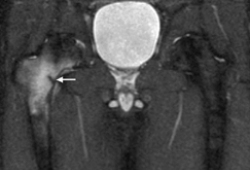Resumo
Definição
História e exame físico
Principais fatores diagnósticos
- presencia de factores de riesgo
- dolor agudo relacionado con un traumatismo
- antecedentes de lesiones relacionadas con el deporte o con lesión por sobrecarga
- prueba de pinzamiento anterior positiva (prueba de FADIR)
- dolor en la aducción contra la resistencia (flexión neutra de cadera)
- dolor a la palpación en los tendones del aductor
- dolor a la palpación en el psoas ilíaco
Outros fatores diagnósticos
- dolor en la prueba de rango de movimiento pasivo en la articulación de la cadera
- cadera en resorte
- prueba positiva de Trendelenburg
- prueba de aprehensión positiva
- prueba de Thomas modificada positiva
- dolor a la palpación en el canal inguinal
- dolor a la palpación en la hoz inguinal de la espina del pubis
- disminución de la fuerza y aumento del dolor con la flexión de la cadera contra la resistencia (90˚)
- dolor durante la noche/dolor en reposo
Fatores de risco
- lesión previa en la ingle
- mayor nivel de juego
- reducción de la fuerza de los abductores y aductores de la cadera
- niveles más bajos de entrenamiento
- mayor edad
- menor rango de movimiento en la cadera
Investigações diagnósticas
Primeiras investigações a serem solicitadas
- radiografías simples (pelvis anteroposterior [AP] y AP y cadera lateral)
Investigações a serem consideradas
- ultrasonido de la cadera
- resonancia magnética (IRM) de la cadera
- artrografía mediante IRM de la cadera
- tomografía computarizada (TC) de la cadera
- gammagrafía ósea con isótopos de la cadera
- inyección intrarticular con corticosteroide ± agente anestésico local
Algoritmo de tratamento
fractura por sobrecarga en el cuello del fémur
lesión traumática o por sobrecarga: presentación inicial
lesión traumática o por sobrecarga: sin respuesta al tratamiento inicial
Colaboradores
Autores
Per Hölmich, MD, DMSc
Professor of Orthopedic Surgery and Chief Surgeon
Sports Orthopedic Research Center – Copenhagen (SORC-C)
Arthroscopy Centre Hvidovre, Department of Orthopedics
Amager & Hvidovre Hospital
University of Copenhagen
Denmark
Declarações
PH is an author of a number of references cited in this topic. PH declares that he has no other competing interests.
Agradecimentos
Dr Per Hölmich would like to gratefully acknowledge Dr Cedric J Ortiguera and Dr Juan M Raposo, the previous contributors to this topic. CJO and JMR declare that they have no competing interests.
Revisores
Carlos Guanche, MD
Specialist in Arthroscopy of the Shoulder, Hip, and Knee; Traditional and Reverse Shoulder Replacement; and Sports Medicine
Southern California Orthopedic Institute
Van Nuys
CA
Declarações
CG declares that he has no competing interests.
Créditos aos pareceristas
Os tópicos do BMJ Best Practice são constantemente atualizados, seguindo os desenvolvimentos das evidências e das diretrizes. Os pareceristas aqui listados revisaram o conteúdo pelo menos uma vez durante a história do tópico.
Declarações
As afiliações e declarações dos pareceristas referem--se ao momento da revisão.
Referências
Principais artigos
European Society of Sports Traumatology, Knee Surgery and Arthroscopy. A formal ESSKA-EHPA-ESMA consensus: hip and groin pain in physically active adults. Oct 2024 [internet publication].Texto completo
Hölmich P. Adductor-related groin pain in athletes. Sports Med Arthrosc. 1997;5:285-291.
Hölmich P, Uhrskou P, Ulnits L, et al. Effectiveness of active physical training as treatment for long-standing adductor-related groin pain in athletes: randomized trial. Lancet. 1999;353:439-443. Resumo
Artigos de referência
Uma lista completa das fontes referenciadas neste tópico está disponível para os usuários com acesso total ao BMJ Best Practice.

Diagnósticos diferenciais
- Displasia de la cadera
- Atrapamiento de un nervio
- Bursitis
Mais Diagnósticos diferenciaisDiretrizes
- Hip and groin pain in physically active adults
Mais DiretrizesConectar-se ou assinar para acessar todo o BMJ Best Practice
O uso deste conteúdo está sujeito ao nosso aviso legal